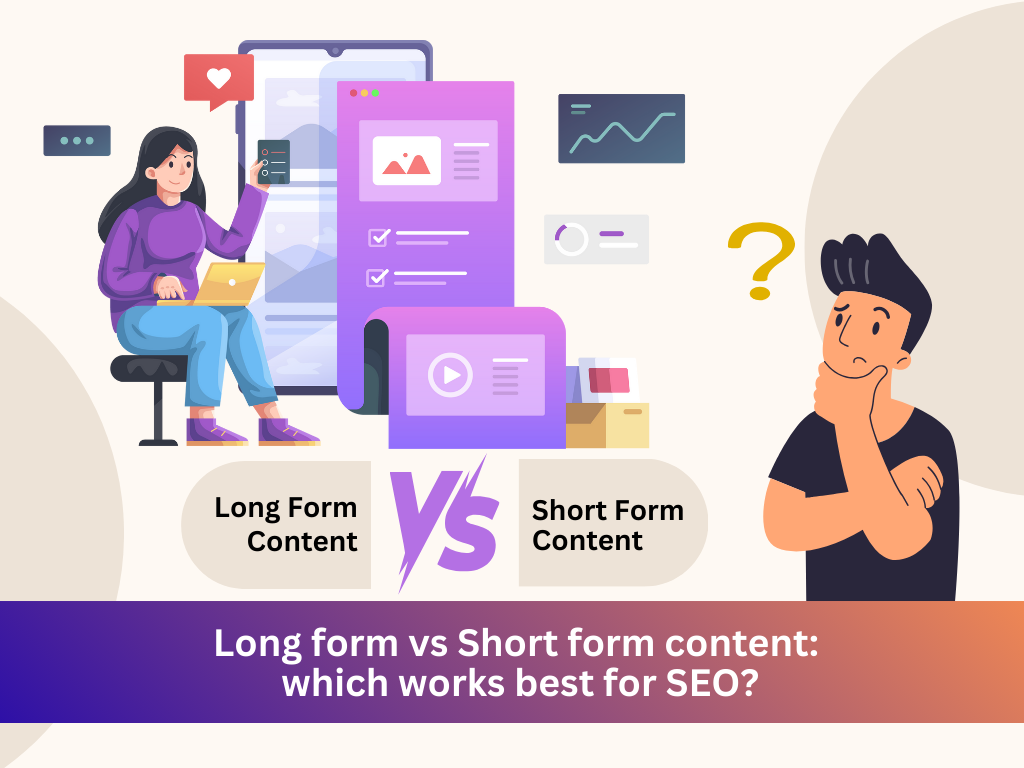
Introduction
When it comes to content marketing and SEO, one of the biggest debates is long-form vs. short-form content. Should you write detailed, in-depth guides or concise, to-the-point articles? Both have their advantages, but which one works best for SEO? This blog will explore the strengths and weaknesses of each format and help you determine the right approach for your content strategy.
What is Long-Form Content?
Long-form content typically exceeds 1,200 words, often going up to 3,000+ words. It includes in-depth guides, case studies, research papers, and comprehensive blog posts that offer detailed insights into a topic.
Advantages of Long-Form Content for SEO
- Higher Google Rankings – Research shows that longer content tends to rank higher on Google SERPs.
- More Backlinks – In-depth articles attract more inbound links, which boost SEO authority.
- Increased Dwell Time – Readers spend more time engaging with long-form articles, which improves user experience signals.
- Better Topic Authority – Long-form content establishes credibility and thought leadership in your industry.
- Higher Social Shares – Comprehensive content is more likely to be shared on social media platforms.
Disadvantages of Long-Form Content
- Requires more time and effort to produce.
- Risk of losing reader engagement if the content is not well-structured.
- Not always suitable for mobile users looking for quick answers.
What is Short-Form Content?
Short-form content is typically under 1,200 words, often 300-800 words. This includes listicles, news updates, social media posts, and brief blog articles that provide quick insights.
Advantages of Short-Form Content for SEO
- Quick Consumption – Ideal for users who want fast, digestible information.
- Higher Engagement on Mobile – Mobile users prefer shorter content due to limited screen space.
- More Frequent Publishing – Easier to produce and publish regularly.
- Better for Social Media – Shorter posts work well on platforms like Twitter, LinkedIn, and Instagram.
- Lower Bounce Rate – Users find quick answers without having to skim through lengthy articles.
Disadvantages of Short-Form Content
- Lower chance of ranking for competitive keywords.
- Fewer backlinks since shorter content may not be considered authoritative.
- Less in-depth coverage of a topic, which may reduce credibility.
Which Works Best for SEO?
The answer depends on several factors, including your audience, industry, and content goals. Here’s a breakdown:
| Factor | Long-form Content | Short-form Content |
| Ranking Potential | ✅ Higher | ❌ Lower |
| Backlink Potential | ✅ Higher | ❌ Lower |
| Engagement | ✅ High (if structured well) | ✅ High (for quick reads) |
| Mobile friendliness | ❌ Can be challenging | ✅ More mobile-friendly |
| Social Shares | ✅ More likely to be shared | ✅ Quick engagement |
| Time Investment | ❌ Requires more time | ✅ Faster to produce |
When to Use Long-Form vs. Short-Form Content
Use Long-Form Content When:
✔ Covering complex topics that need detailed explanation.
✔ Targeting high-competition keywords.
✔ Building thought leadership and authority in your industry.
✔ Aiming for more backlinks and organic traffic.
Use Short-Form Content When:
✔ Sharing breaking news or quick updates.
✔ Targeting a mobile-first audience.
✔ Creating social media-friendly content.
✔ Maintaining a high-frequency publishing schedule.
Both long-form and short-form content have their place in a well-rounded SEO strategy. Long-form content excels in rankings, backlinks, and engagement, while short-form content performs well for quick consumption and social media reach. The best approach is to strike a balance—use long-form content for evergreen, high-value topics and short-form content for timely, snackable insights.
